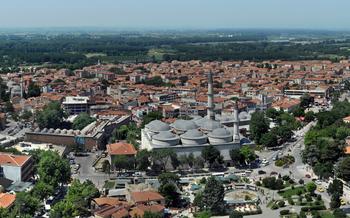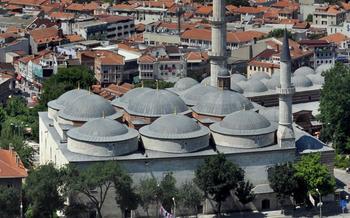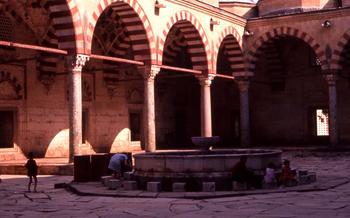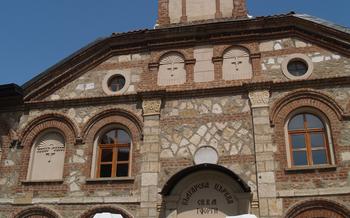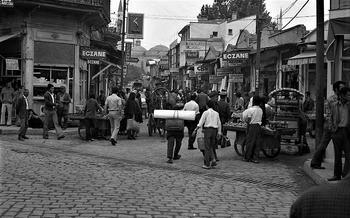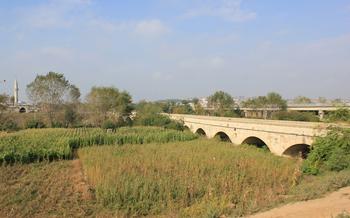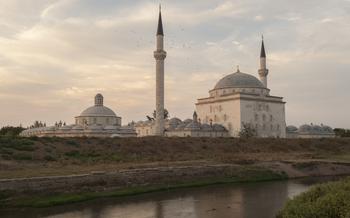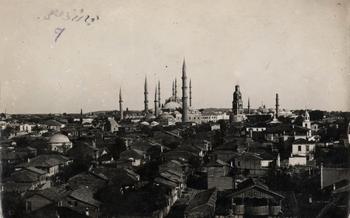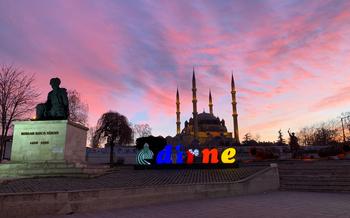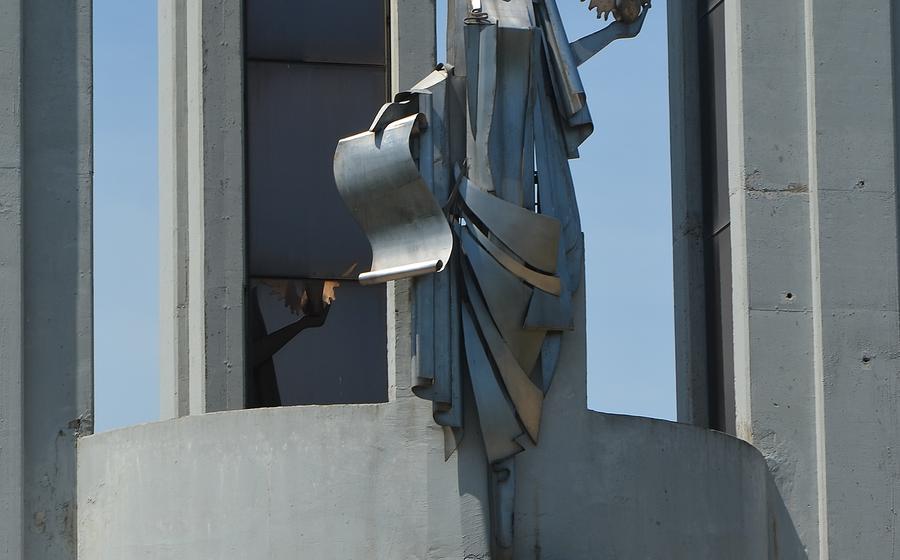
Peace Monument at Karaagac
- Peace Monument at Karaagac: A Symbol of Unity and Remembrance
- Location and Accessibility
- Exploring the Monument's Surroundings
- Significance of Karaagac in Turkish History
- Unveiling the Meaning Behind the Monument's Design
- Karaagac: A Bridge Between Cultures and Nations
- Visiting the Monument: Practical Tips and Information
- Reminiscing the Past: The Balkan Wars and Their Impact
- Honoring the Fallen: A Tribute to Turkish Soldiers
- Experiencing Edirne: A City Rich in History and Culture
- Karaagac: A Place for Reflection and Remembrance
- The Peace Monument: A Testament to Resilience
- Capturing the Beauty of Karaagac: Photography Tips
- Unforgettable Moments: Sharing Visitor Experiences
- Insider Tip: Unveiling the Hidden Gem
Peace Monument at Karaagac: A Symbol of Unity and Remembrance
The Peace Monument at Karaagac stands as a testament to the enduring friendship between Turkey and Bulgaria. Unveiled in 1953, the monument commemorates the Turkish soldiers who sacrificed their lives during the Balkan Wars and symbolizes the shared desire for peace and harmony between the two nations.
With its unique architectural design, the monument portrays two hands, representing Turkey and Bulgaria, reaching out to each other in a gesture of unity and solidarity. The hands rest upon a globe, signifying the common ground and shared history that bind the two countries.
The monument also serves as a poignant reminder of the sacrifices made by Turkish soldiers in the Balkan Wars, which were fought between 1912 and 19The monument honors the bravery and dedication of those who fought for Turkey's independence and sovereignty, ensuring that their memory lives on.
Beyond its historical significance, the Peace Monument at Karaagac is a symbol of peace and tranquility, embodying the hope for lasting friendship and cooperation between Turkey and Bulgaria. It stands as a beacon of unity, reminding visitors of the power of reconciliation and the importance of working together to build a better future for both nations.
Location and Accessibility
The Peace Monument at Karaagac is strategically situated at the border of Turkey and Bulgaria, specifically in the Edirne province. Its exact address is Karaagac, 22100 Merkez/Edirne. To reach the monument from Edirne city center, visitors can conveniently take public transportation, with buses departing regularly from the city's main bus station. The journey takes approximately 30 minutes, providing a comfortable and direct route to Karaagac.
Alternatively, guided tours are available for those seeking a more comprehensive experience. These tours typically include transportation from Edirne city center, allowing visitors to relax and focus on the historical significance of the monument. Prior booking and reservations are recommended to secure a spot on these informative and engaging tours.
For those arriving by car, ample parking facilities are available in the vicinity of the monument. Designated parking areas ensure a hassle-free visit, enabling travelers to park conveniently and explore the monument at their leisure.
Exploring the Monument's Surroundings
Karaagac, with its historical significance, is nestled amidst an array of notable landmarks and attractions. History enthusiasts can delve into the past at the nearby Museum of Turkish and Islamic Arts, which houses a rich collection of artifacts and manuscripts. The imposing Edirne Fortress, a testament to the city's resilience, stands as a silent witness to bygone eras.
For those seeking a spiritual connection, the Selimiye Mosque, a masterpiece of Ottoman architecture, beckons with its intricate tilework and soaring minarets. A visit to the Old Bazaar, a labyrinth of vibrant shops and stalls, offers a glimpse into the city's bustling commercial past.
When hunger strikes, savor the delectable flavors of Turkish cuisine at one of the many restaurants in the area. From traditional kebabs to freshly caught seafood, the culinary delights of Edirne promise a tantalizing feast. After a fulfilling meal, take a leisurely stroll along the banks of the Tunca River, where the tranquil waters create a serene ambiance.
Karaagac also provides opportunities for outdoor recreation and entertainment. The sprawling Karaagac Park, with its verdant lawns and walking trails, invites visitors to indulge in leisurely picnics or invigorating jogs. For a touch of excitement, head to the nearby amusement park, where thrilling rides and attractions await.
Significance of Karaagac in Turkish History
Karaagac holds a significant place in Turkish history, particularly in relation to the Balkan Wars. During these conflicts, the town of Karaagac and its surrounding areas witnessed intense battles and played a crucial role in the Turkish struggle for independence and sovereignty. The monument stands as a poignant reminder of the sacrifices made by Turkish soldiers and the determination of the Turkish people to defend their homeland.
Karaagac served as a strategic location during the Balkan Wars, with its proximity to the border between Turkey and Bulgaria making it a key battleground. Turkish forces fought valiantly to repel Bulgarian advances and protect the territorial integrity of their nation. The Peace Monument at Karaagac commemorates the bravery of these soldiers and honors their ultimate sacrifice.
The battles fought in and around Karaagac were instrumental in shaping the course of Turkish history. The resilience and determination displayed by the Turkish army and the local population contributed to the eventual success of the Turkish national liberation movement. The monument serves as a reminder of the struggles and sacrifices that led to the establishment of an independent and sovereign Turkish state.
Karaagac also holds symbolic significance as a place where Turkish and Bulgarian soldiers fought side by side against a common enemy. The Peace Monument stands as a testament to the shared history and common heritage of these two neighboring nations, encouraging reconciliation and promoting peace and understanding between them.
Unveiling the Meaning Behind the Monument's Design
The Peace Monument at Karaagac is not merely a structure but a profound representation of unity and peace. Its design holds a wealth of symbolism, inviting visitors to contemplate the powerful message it conveys. The two hands reaching out to each other are a universal symbol of peace, representing the desire for harmony and understanding between nations. The hands are crafted in intricate detail, expressing the delicate nature of peace and the commitment required to maintain it.
The monument's architectural elements contribute to its overall impact. The use of stone symbolizes strength and resilience, while the smooth, curved lines suggest a sense of fluidity and movement. The monument's height adds to its grandeur, making it a striking landmark that commands attention.
As visitors stand before the monument, they are captivated by its emotional impact. The symbolism of the hands and the serene atmosphere created by the monument's design evoke a sense of peace and tranquility. It encourages contemplation and reflection on the importance of unity and the sacrifices made to achieve it. The monument's design is a testament to the power of art to convey powerful messages and inspire positive change.
Karaagac: A Bridge Between Cultures and Nations
Karaagac is not just a monument; it stands as a testament to the strong bond between Turkey and Bulgaria. The two nations share a rich history, marked by cultural exchanges, collaborations, and a common heritage. The monument serves as a symbol of friendship and cooperation between these neighboring countries.
Through the Peace Monument, Turkey and Bulgaria have demonstrated their commitment to fostering peace, understanding, and harmony. The monument serves as a constant reminder of the shared sacrifices made during the Balkan Wars and the subsequent journey towards reconciliation. It encourages both nations to continue working together, building bridges of friendship and cooperation for a brighter future.
The monument's design, featuring two hands reaching out to each other, encapsulates the essence of this unity and cooperation. It represents the willingness of both countries to embrace one another, to work together for the betterment of their people, and to create a lasting legacy of peace and friendship.
Visiting the Monument: Practical Tips and Information
Opening Hours and Admission:
The Peace Monument at Karaagac is accessible to visitors throughout the day, every day of the week. Admission is free of charge, allowing everyone to experience this symbolic monument without any financial barriers.
Guided Tours:
Guided tours are available upon request for groups or individuals seeking a deeper understanding of the monument's history, significance, and symbolism. These tours are led by knowledgeable guides who provide insightful commentary, historical context, and personal anecdotes, enhancing the overall visitor experience.
Best Time to Visit:
The optimal time to visit the Peace Monument is during the spring or fall, when the weather is generally pleasant and conducive to outdoor exploration. During these seasons, the surrounding gardens are in full bloom, providing a picturesque backdrop for the monument.
Photography Tips:
For those interested in capturing the beauty of the monument through photography, it is recommended to visit during the golden hours, shortly after sunrise or before sunset, when the warm, diffused light casts a magical glow on the monument and its surroundings.
Tips for Photography:
To capture stunning photographs, photographers should consider using a wide-angle lens to encompass the monument's grandeur. Experiment with different angles and perspectives to create unique and dynamic compositions. Additionally, tripod usage is recommended for stability and sharp images.
Reminiscing the Past: The Balkan Wars and Their Impact
The Balkan Wars, which occurred between 1912 and 1913, were a series of conflicts that significantly impacted the region and its people. These wars involved several Balkan states, including Turkey, and had far-reaching consequences for the political and territorial landscape of the region.
Karaagac played a crucial role in the Balkan Wars, serving as a strategic location for both the Ottoman and Bulgarian forces. The town was fiercely contested, and the battles fought here were among the most intense and decisive of the entire conflict. The Peace Monument stands as a poignant reminder of the sacrifices made by Turkish soldiers during these wars.
The Balkan Wars had a profound impact on the region, leading to significant shifts in borders and the emergence of new nation-states. The wars also had a devastating human toll, resulting in the loss of countless lives and the displacement of millions of people. Karaagac, with its rich history and strategic importance, bears witness to the complexities and consequences of this tumultuous period.
Honoring the Fallen: A Tribute to Turkish Soldiers
The Peace Monument at Karaagac stands as a solemn tribute to the brave Turkish soldiers who lost their lives in the Balkan Wars. Their ultimate sacrifice paved the way for Turkish independence and sovereignty, and the monument serves as a poignant reminder of their valor and dedication.
The monument's design incorporates powerful symbolism that honors these fallen heroes. The two hands reaching out, one representing Turkey and the other Bulgaria, symbolize the unity and reconciliation that emerged after the conflicts. The hands also cradle a wreath, a symbol of victory and remembrance.
Each year, on the anniversary of the Balkan Wars, memorial ceremonies are held at the monument to pay tribute to the fallen soldiers. These ceremonies are attended by Turkish officials, military personnel, and the general public, who come together to honor the sacrifices made by these brave men.
Visitors to the monument are often moved by the sense of reverence and gratitude that permeates the air. The monument stands as a testament to the indomitable spirit of the Turkish people and their unwavering commitment to freedom and independence.
Experiencing Edirne: A City Rich in History and Culture
Edirne, the city that proudly hosts the Peace Monument at Karaagac, is a treasure trove of historical and cultural wonders. Steeped in centuries of rich heritage, Edirne served as the capital of the Ottoman Empire during its golden age. Explore the grandeur of Selimiye Mosque, an architectural masterpiece that stands as a testament to Ottoman ingenuity and artistry. Marvel at the intricate tilework and soaring minarets of Üç Şerefeli Mosque, a unique symbol of Ottoman craftsmanship.
Indulge in the delectable flavors of Edirne's renowned cuisine, tantalizing your taste buds with traditional dishes such as tava ciğeri (pan-fried liver), keşkek (a hearty wheat and meat stew), and the sweet treat of ekmek kadayıfı (shredded wheat dessert). Immerse yourself in the vibrant atmosphere of the city's markets, where you can haggle for unique souvenirs and handicrafts that reflect the essence of Turkish culture.
Edirne is also a vibrant city that celebrates its heritage through captivating festivals and events. Witness the spectacle of the annual Kırkpınar Oil Wrestling Festival, a centuries-old tradition that showcases the strength and agility of Turkish wrestlers. Experience the infectious energy of the Edirne Carnival, where colorful parades, music, and dance fill the streets, creating an unforgettable spectacle.
Whether you're a history buff, a culinary enthusiast, or simply seeking a vibrant cultural experience, Edirne offers an array of attractions and activities that will leave you spellbound.
Karaagac: A Place for Reflection and Remembrance
The Peace Monument at Karaagac stands as a solemn reminder of the sacrifices made during the Balkan Wars and a symbol of the resilience of the Turkish people. It invites visitors to pause and reflect on the fragility of peace and the importance of unity. The monument encourages contemplation of the past struggles and the sacrifices made by Turkish soldiers to secure their nation's independence and sovereignty. It fosters a sense of gratitude and respect for their bravery and unwavering commitment to their homeland. By paying homage to the fallen, the monument inspires visitors to reflect on the devastating consequences of war and the preciousness of peace. It serves as a reminder of the need for dialogue, understanding, and cooperation among nations to prevent future conflicts and build a more harmonious world.
The Peace Monument: A Testament to Resilience
The Peace Monument at Karaagac stands as a testament to the resilience and unwavering spirit of the Turkish people. It serves as a reminder that even amidst adversity and challenges, peace and unity can prevail. The monument symbolizes the Turkish nation's ability to overcome obstacles, rise above conflicts, and forge a path towards a brighter future.
The monument's design, with its two hands reaching out, evokes a sense of strength and determination. It represents the Turkish people's commitment to overcoming challenges and building a peaceful and prosperous society. The monument's message of resilience resonates with visitors from all walks of life, inspiring them to face their own challenges with courage and perseverance.
The Peace Monument at Karaagac is not just a historical landmark; it is a living symbol of the Turkish people's resilience and unwavering spirit. It stands as a reminder that even in the darkest of times, the power of unity and determination can lead to a brighter future.
Capturing the Beauty of Karaagac: Photography Tips
Embrace the Golden Hour: Arrive at the monument during the golden hour, just before sunset or after sunrise, to capture the warm, diffused light that enhances the monument's beauty and creates stunning silhouettes.
Play with Perspectives: Experiment with different angles and perspectives to create unique and dynamic shots. Capture the monument from below to emphasize its grandeur, or try a bird's-eye view to showcase its surroundings.
Master the Tripod: Utilize a tripod for stability and precision, especially when shooting in low-light conditions or using long exposure techniques. This will minimize camera shake and ensure sharp, detailed images.
Compose with Intention: Pay attention to composition and leading lines to draw the viewer's eye towards the monument. Incorporate elements like trees, pathways, or the nearby river to create a sense of depth and context.
Capture the Emotions: Aim to capture not just the physical beauty of the monument but also the emotions and symbolism it evokes. Look for moments of contemplation, remembrance, or connection between visitors and the memorial.
Experiment with Black and White: Consider converting your photos to black and white to create a timeless, dramatic effect that emphasizes the monument's historic significance and emotional weight.
Seek Unique Details: Look for intricate details and architectural elements that often go unnoticed. Close-up shots of the hands, inscriptions, or surrounding landscaping can add depth and interest to your photographs.
Unforgettable Moments: Sharing Visitor Experiences
The Peace Monument at Karaagac has left an indelible mark on travelers from all walks of life. Visitors often share their personal anecdotes and reflections, highlighting the emotional connections they have formed with the monument and its surroundings. For some, it is a place of deep contemplation, where they are reminded of the fragility of peace and the importance of fostering unity among nations. Others are moved by the stories of the brave Turkish soldiers who fought and sacrificed their lives for their country's independence. The monument serves as a powerful reminder of the resilience and determination of the Turkish people, inspiring visitors to overcome challenges and adversity in their own lives.
One visitor, a young woman from Germany, recounted her experience of visiting the monument during a solo trip to Edirne. She was captivated by the serene atmosphere and the monument's poignant symbolism, which resonated deeply with her own personal journey of self-discovery and growth. Another traveler, a retired professor from the United States, shared how the monument sparked his interest in Turkish history and culture, leading him to delve deeper into the region's rich heritage and traditions.
These personal accounts underscore the universal appeal of the Peace Monument at Karaagac, which transcends cultural and geographical boundaries. Visitors from different backgrounds and walks of life find solace, inspiration, and a renewed appreciation for peace and unity within its tranquil surroundings.
Insider Tip: Unveiling the Hidden Gem
Beyond the Peace Monument, Karaagac holds a treasure trove of hidden gems waiting to be discovered. Just a short walk from the monument lies the captivating Karaagac Railway Station, a century-old architectural marvel that has stood witness to the passage of time. With its intricate stonework and beautifully preserved facade, the station offers a glimpse into Edirne's rich railway heritage.
History enthusiasts will also find solace in the Karaagac War Museum, which houses a collection of artifacts, photographs, and documents chronicling the region's military past. Delve into the stories of bravery and sacrifice that have shaped this land, and gain a deeper understanding of the significance of Karaagac in Turkish history.
For a taste of local delights, venture into the heart of Karaagac and seek out the inviting Aile Sofrasi Restaurant. This family-run establishment serves up authentic Turkish cuisine prepared with fresh, seasonal ingredients. Savor the flavors of traditional dishes such as Iskender kebab, borek, and tavuk gogsu, and immerse yourself in the warm hospitality of the Turkish people.
To fully embrace the local culture, time your visit to coincide with one of Karaagac's vibrant festivals. The Karaagac Cherry Festival, held annually in June, celebrates the region's abundant cherry harvest with music, dance, and traditional games. Don't miss the opportunity to sample the mouthwatering cherry-based delicacies and immerse yourself in the festive atmosphere.
As you explore Karaagac, take the time to engage with the locals and learn about their stories and traditions. Whether it's sharing a cup of cay at a local teahouse or striking up a conversation at the bustling Karaagac Market, these interactions will provide invaluable insights into the soul of this historic town.

